Balls Falls Conservation Area Guide: Everything You Need to Know

It’s no secret that the Niagara Region offers spectacular scenery. There’s a reason why so many fall in love with the area! If you’re looking for a fantastic spot to spend a day hiking here, Ball’s Falls Conservation is home to some of the best trails in Niagara. It’s not only home to two dazzling waterfalls but there’s plenty of history to be uncovered… and a spooky side too! If you love chasing waterfalls, being in nature, have an interest in local history or wonder what goes bump in the night, then you need to plan a visit to Ball’s Falls Conservation Area!
Balls Falls Conservation Area spans over 200 acres and is set within the stunning Twenty Valley in Lincoln, Ontario. While this property once belonged to the Ball Family (hence the name), it is now overseen by the Niagara Peninsula Conservation Authority. They maintain this park along with 32 other conservation areas in and around the region as well as protect the unique flora and fauna found in this specific area of Niagara. However, this area is the traditional territory of the Anishinaabe, Attiwonderonk (Neutral) and the Haudenosaunee Peoples and is covered by Upper Canada Treaties 3, 4 and 381. Many First Nations, Métis, and Inuit peoples call Niagara home to this very day.
Disclaimer: This post may contain affiliate links where I may receive a kickback at no extra cost to you. It helps keep IBB alive so thank you!
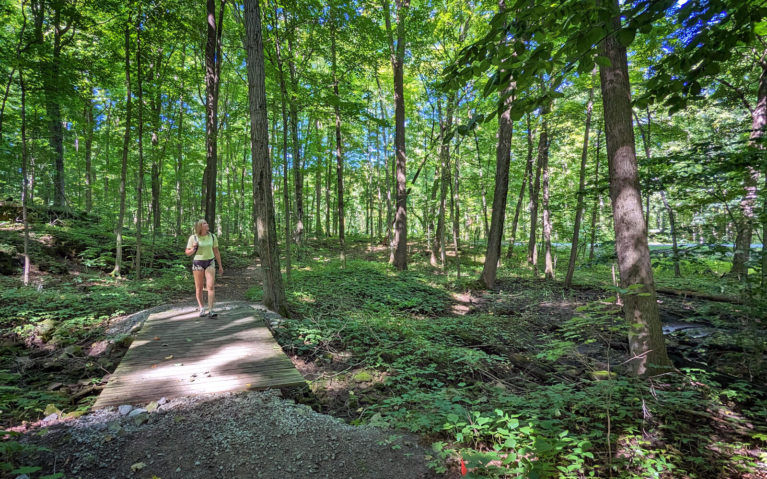
Along the Forest Frolic Trail in Ball’s Falls Conservation Area
TABLE OF CONTENTS
Ball’s Falls Hiking Trails
Chances are if you’re visiting Ball’s Falls, it’s to get your hike on and check out some waterfalls. Ball’s Falls is home to five hiking trails for over 5 kilometres of interconnected routes. Four trails are contained within the park: the Cataract Trail, the Forest Frolic Trail, the Switchback Trail, and the Village Trail. The Bruce Trail, Ontario’s longest hiking trail, runs through the park as it follows the Niagara Escarpment.
Here are some more details about each of the hiking trails in Balls Falls Conservation Area. I’ve put them in the order I recommend you experience them, starting at the main parking lot. Of course if you’d rather explore in a different order, follow your heart and do as you please!
Forest Frolic Trail
Length: 850 metres
Located behind the Balls Falls Centre for Conservation to the right of the entrance gates, the Forest Frolic Trail is often overlooked by visitors. However, it’s bursting with whimsy and has a different feel compared to the other trails in the park!
Follow the yellow arrows as you loop your way around the dense forest. While you’ll catch glimpses of Sixth Avenue, you’ll barely hear any cars as the wind rustles through the leaves. Enjoy a leisurely stroll across numerous wooden bridges as you admire the towering trees above you.
There is some elevation though it is quite moderate, making it a great hike for families with toddlers or those looking to enjoy something a little calmer.
Switchback Trail
Length: 600 metres
The Switchback Trail is exactly that, a switchback, that connects with both the Cataract and Village Trails. This is mostly paved and allows folks to gradually tackle the difference in elevation as opposed to starting directly with the Cataract Trail which some folks could deem as difficult.
If you’re looking to head directly to the Village Trail and Lower Ball’s Falls, you’ll need to take the Switchback Trail. Then, follow the trail to your left towards the historical buildings. However, I recommend heading right first along the Cataract Trail to see Upper Ball’s Falls first.
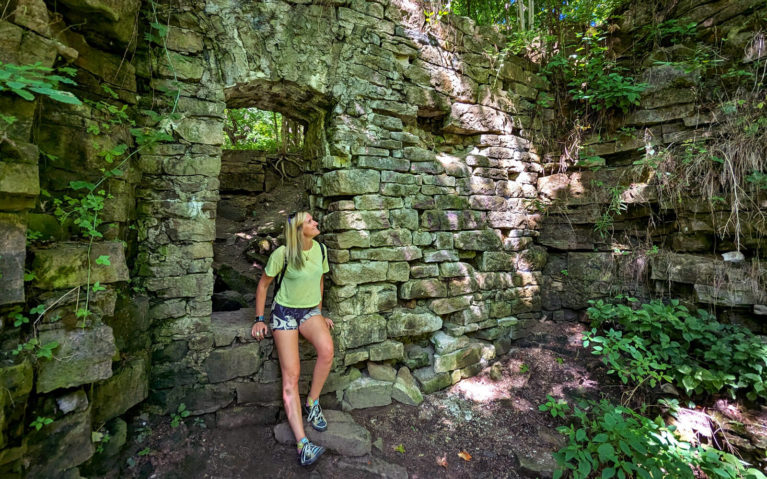
Checking Out the Woolen Mill Ruins Along the Cataract Trail
Cataract Trail to Upper Ball’s Falls
Length: 1.7 kilometres
The Cataract Trail is the longest trail within the Ball’s Falls Conservation Area. Creating a loop with the Switchback Trail that connects to the Centre for Conservation, you will face some steady hills as you make your way toward the trail’s highlight: Upper Ball’s Falls.
As you follow Twenty Mile Creek, you will pass what’s left of the Woolen Mill constructed by the Ball Family in 1824. During its prime, water was diverted to bypass the Upper Falls and channelled towards the mill, allowing it enough water supply to operate eight looms without constructing a dam. It was later renovated in the 1840s in order to manufacture cloth utilizing steam power as well. There is not much left of this five-story building but it makes for an interesting spot to explore. Be careful descending towards the still-standing doorway as the terrain can be slippery!
If you leave from the Centre for Conservation, you will follow the trail to Upper Balls Falls and then keep to your right, following Twenty Mile Creek to continue along the Cataract Trail. However, if you access the trail from the Switchback, you can either retrace your steps and continue along the Village Trail or take the left access which will lead you to the Centre for Conservation.
Village Trail to Lower Ball’s Falls
Length: 1.3 kilometres
Connecting with the Switchback and Cataract Trails, this out and back trail crosses Twenty Mile Creek towards the historical village. Here you’ll find seven of the original buildings belonging to the Ball family: the Ball family home, church, Fairchild cabin, Furry cabin, blacksmith shop, barn and grist mill. Some of the buildings such as the barn and grist mill are occasionally open (usually on weekends in the summer or during special events) so you can learn more about what life was like for the Ball family.
Continue on past the grist mill and you will find the best views in the park at the lookout for Lower Ball’s Falls! There is a picnic table and bench, making this a great spot to rest as you listen to the water tumble over the escarpment.
Bruce Trail to Ball’s Falls
Length: Varies
As you can see, the hiking trails in Balls Falls Conservation Area are relatively easy and can be completed in approximately two hours or less. If you’re looking to take it up a notch, I recommend adding a stretch of the Bruce Trail to your plan!
The Bruce Trail runs through the park as it follows the top of the Niagara Escarpment near Lower Ball’s Falls. You can access it from Victoria Avenue or Glen Road. If you have one car and don’t mind backtracking, I recommend parking at the lot off of Glen Road and following the Bruce Trail. The terrain is much more difficult and will certainly get the blood pumping! You also have the option of hiking right through to Victoria Avenue or further depending on how much ground you want to cover. There is no official parking off of Victoria Avenue so if you choose to do so, you may be ticketed.
If you’re looking to spend a day exploring the Bruce Trail and have two cars, you can enjoy two Niagara Peninsula Conservation Authority sites. Park off Glen Road and then follow the Bruce Trail through Ball’s Falls all the way to Cave Springs Conservation Area. Not only is this a great workout but you’ll pass by a number of wineries along the way if you need a pit stop to rest and recharge! You can view the route here.
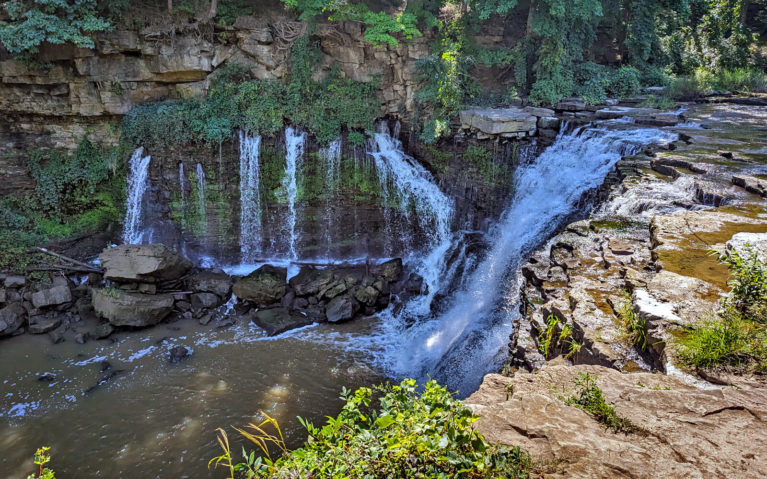
Late Morning View of Upper Ball’s Falls
Ball’s Falls Conservation Area Waterfalls
Hiking is always better when rewarded with beautiful views and you’ll find not one but two stunning waterfalls here! Twenty Mile Creek tumbles over the land twice to form the best things to do in Ball’s Falls Conservation Area. I highly recommend visiting Upper Balls Falls first and the Lowe Falls second. By looking at the photos, I’m sure you’ll see understand why!
RELATED: Looking for more waterfalls in the region? Check out my guide to the best waterfalls in Niagara!
Upper Balls Falls
Standing at 11 metres tall, Upper Balls Falls is a gorgeous curtain waterfall. It’s wider than it is tall as Twenty Mile Creek flows through every nook and cranny of the area’s dolostone.
Water flow can vary heavily as Twenty Mile Creek is dependent on rain as its main source. As with most waterfalls, early spring is the best time to see Upper Balls Falls in all her glory! When the water levels are low in the summer however, you can walk along some of the rocks upstream in the middle of Twenty Mile Creek which will give you a unique view of the gorge below.
INSIDER TIP: For the best views of Upper Balls Falls, it’s best to visit later in the afternoon as the sun will illuminate the falls.
While there is a way to access the base of Upper Balls Falls, it’s not recommended by the Niagara Peninsula Conservation Authority due to safety concerns.
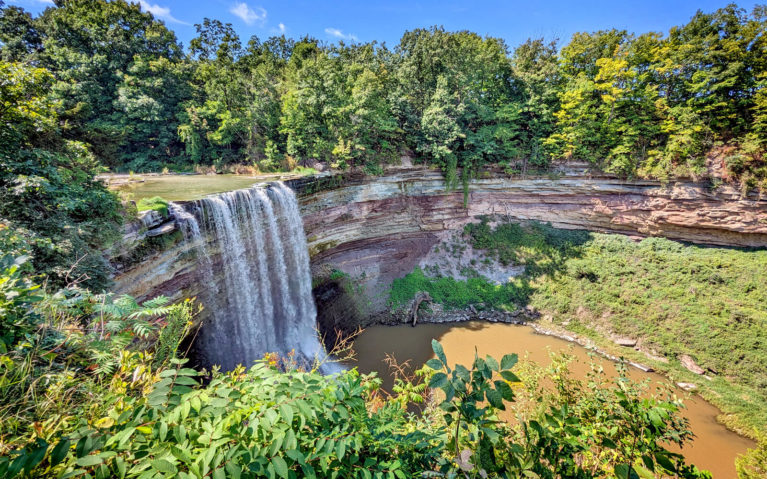
Lower Ball’s Falls in Late Summer
Lower Balls Falls
The top attraction in Balls Falls Conservation Area – say hello to Lower Balls Falls. Standing 27 metres tall, this classic waterfall is one of the best waterfalls in Niagara. She’s considered a classic waterfall as her width and height are almost equal, depending on water flow.
You can admire her stunning beauty as well as the intricate layers of bedrock from the lookout in the Balls Falls Conservation Area. From here, you can connect to the Bruce Trail which will lead you around the edge of the Escarpment for a few more vantage points, though they’re best seen when the leaves have fallen off the trees.
It’s said that you can access the base of Lower Balls Falls from the Bruce Trail further downstream. I have never done so and once again, it’s not advised due to safety reasons so do so at your own risk.

Ball Family Home in the Heritage Village
Ball’s Falls Heritage Village
Ball’s Falls Conservation Area encompasses 200 of the original 1200 acres awarded to George and John Ball for their loyalty to the British during the American Revolution. Originally settled in 1807, they immediately began to utilize the land and built a grist mill in 1809. The first of three mills built on-site, here they ground wheat, corn, oats, rye and barley for the budding community. It even supplied flower to the British Army during the War of 1812!
Less than a decade later, the Saw Mill was built in 1816. They utilized the flow of the Lower Falls to craft lumber from the timber harvested on-site. This lumber was sold to surrounding villages and towns to construct a number of local houses and buildings. Many of the buildings you see in the heritage village are crafted by said lumber!
Lastly, the Woolen Mill was erected in 1824 for the production of cloth and yarn for local and export markets. These are the ruins you’ll pass along the Cataract Trail to Upper Ball’s Falls.
FUN FACT: The Grist Mill still works to this very day and you can see it in action during the Thanksgiving Festival!
During that time, a cooper’s shop producing barrels for shipping the grist mill’s flour, two lime kilns, a blacksmith’s shop and several houses were constructed. As you can imagine, this employed a number of people and by 1840, this tiny village was known as Glen Elgin.
Unfortunately, Glen Elgin didn’t last long. With the arrival of the Great Western Railway in the 1950s, industries began to locate near its route. The once bustling Glen Elgin became one of Ontario’s ghost towns and in 1962, the property was sold to the Niagara Conservation Authority by Manly Ball.
The Spooky Side of Glen Elgin
As I mentioned, Glen Elgin became a ghost town with the arrival of the Great Western Railway. However, that’s not the only ghoulish thing about it!
Legend has it that a woman who lived in town found out her husband died in the War of 1812. It’s said that she didn’t take the news well. Rather than live without him, she walked to the Upper Falls where she plunged to her death so she could be reunited with her dead love. Some even say she was wearing her wedding gown as she did this!
Does this mean Balls Falls is haunted? It’s a possibility as there have been sightings of a woman in a striking white gown roaming around Upper Ball’s Falls…
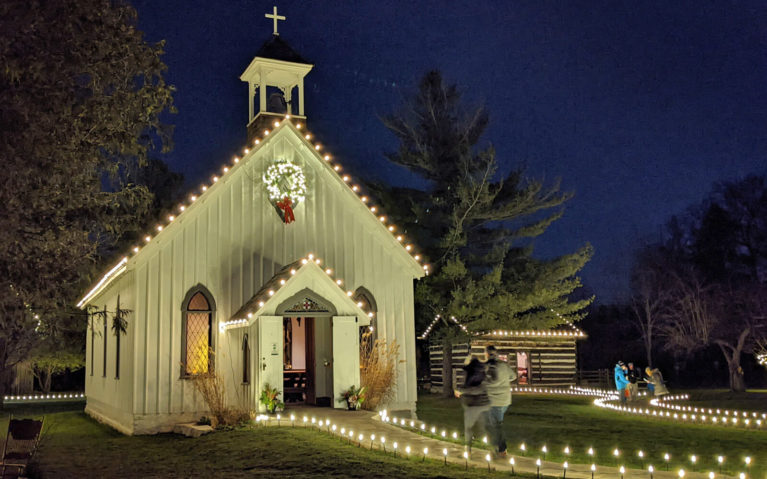
The Heritage Church Decorated for the Ball’s Falls Holiday Trail
Balls Falls Conservation Area Events
Ball’s Falls Conservation Area isn’t just a great spot to go for a hike but it hosts a number of amazing events! Known best for the Ball’s Falls Thanksgiving Festival, visitors can enjoy unique experiences on-site throughout the year.
Balls Falls Thanksgiving Festival
With the purpose of raising money for conservation and environmental programs, the Ball’s Falls Thanksgiving Festival is a local favourite and a sure sign of fall. While the first festival in 1974 was just a single-day event, it has since expanded into a long weekend affair. Celebrating its 49th year in 2023, visitors will find over 150 unique artisans and vendors, heritage tours, guided hikes, live music, amazing eats along with a plethora of craft beverages and local wines.
The 2023 Ball’s Falls Thanksgiving Festival is from Friday, October 6th until Monday, October 9th from 10:00 am to 5:00 pm. Click here for more information. It’s recommended to purchase tickets in advance online as well as have cash handy as a number of vendors do not accept credit or debit payments.
Balls Falls Holiday Trail
While it has yet to be announced for 2023, the Ball’s Falls Holiday Trail has been a hit for the past three winters so I’d be surprised if it doesn’t return for its fourth instalment. Thousands of twinkling lights decorate the already gorgeous conservation area and are sure to put you in the spirit of the season!
Enjoy a 1.5 kilometre evening trail walk experience throughout the Niagara Escarpment, Twenty Mile Creek and the heritage village. Fit for all ages, visitors can enjoy live music, delicious eats and treats, craft stations and special tours of the Ball Family Home.
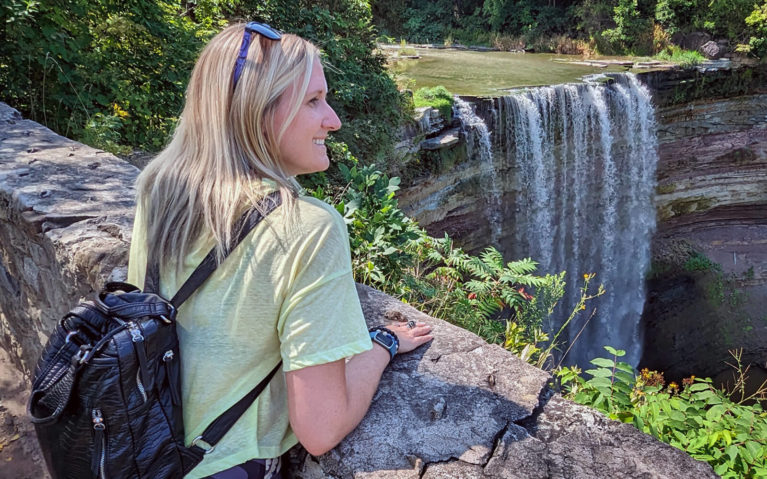
Lower Ball’s Falls Sure is a Stunner!
Planning Your Visit
Ball’s Falls Conservation Area is located at 3292 Sixth Avenue in Lincoln, Ontario. Click here for the map location and directions. The conservation area is open from 8:00 am until 8:00 pm daily. Parking and admission fees vary depending on when you visit. Admission is $13.75 per vehicle (including driver) and any additional passenger is $4.75 for a maximum of $28.00 per car during the peak season. Seniors and students enjoy a discounted rate of $10.25 per vehicle and $3.75 per additional passenger.
During the hours of 9:00 am and 4:00 pm, head into the Ball’s Falls Centre for Conservation to pay your fees. If you visit outside these hours, admission is $13.75 and is paid at the automated gate upon exiting the conservation area. During the fall and winter off-season, admission is $8.50 and is once again paid at the automated gate.
While the Balls Falls hike is quite tame compared to some of the other hiking trails in Ontario, it’s still a good idea to be prepared. Ensure to pack some solid footwear such as running shoes or hiking boots, a bottle of water, some sunscreen for the hot summer days as well as some bug repellant to keep the pesky mosquitoes at bay.
Ball’s Falls is accessible in the winter and I highly recommend visiting once the ice and snow arrive! It’s not uncommon for the waterfalls to freeze over which is quite the sight to see. The trails can be slick however so if you plan to visit Balls Falls Conservation Area in the winter, check out my winter hiking gear guide to ensure you’re prepared!
Looking to Extend Your Stay in Niagara?
The Niagara Region has so much to offer both locals and visitors alike. With Rockway Falls a short 10 minute drive away, the adorable villages of Vineland and Jordan close by, a plethora of fantastic Niagara wineries, and numerous other points of interest, it’s easy to make Ball’s Falls a part of a larger Niagara getaway.
If you’re looking for hotels in Niagara that are close by, I recommend Inn on the Twenty. This upscale boutique hotel is located in the charming village of Jordan and features elegantly decorated suites, an on-site spa and wine cellars as well as numerous restaurants and boutique shops just steps from the hotel. Another fantastic option is the Jordan House Hotel where you’ll feel cozy in this inn that’s bursting with cottage chic. It also features a prime location in the village of Jordan, making it a more affordable option for those looking to stay in the area.
Of course, there are a number of beautiful boutique hotels and properties in the area so if neither of these are available, take a look at the map below for more Niagara hotels and accommodations.


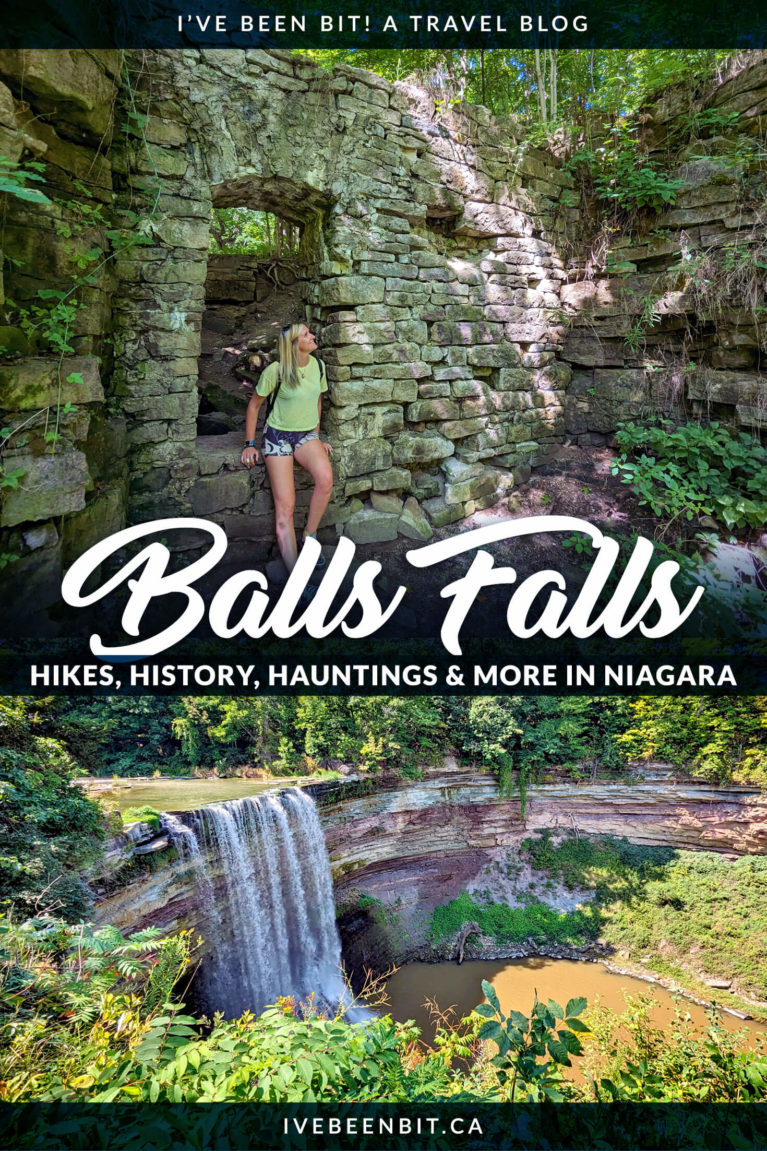








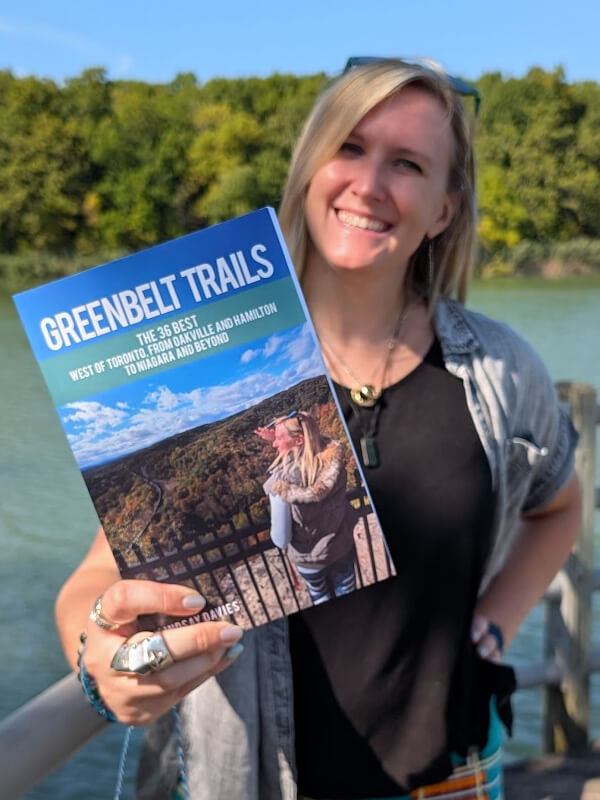


Share Your Thoughts